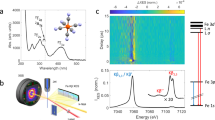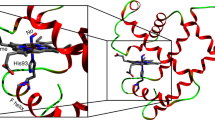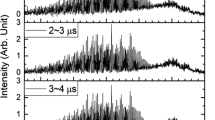Abstract
Carbon monoxide and haemoproteins (Fe2+) form ligand–protein complexes that are photodissociated with high quantum efficiency by visible light1,2. By photolysing the CO–protein complex with pulsed laser radiation it is possible to generate transient species with properties which reflect both the nature of the photolytic and recombination processes as well as non-equilibrium protein dynamics. Using a single pulse both to photolyse and examine the sample, we previously reported3 the resonance Raman spectrum of a transient species of haemoglobin (Hb) occurring within 10 ns of the photodissociation of carboxyhaemoglobin (HbCO). Transient species generated by photodissociating HbCO have been intensively studied by using transient absorption spectroscopy covering picosecond4–6, nanosecond7–10 and longer time scales11–15. The overlap of the absorption bands related to various species can hamper the extraction of quantitative information from absorption spectra. Nevertheless, progress has been reported, in particular, the results of nanosecond transient absorption studies9,10 reported after the experiments described here were well under way. Those results, including re-interpretation of earlier data8, led to the suggestion9,10 that photolysis of HbCO actually leads to a near-unity quantum yield of a deoxy-Hb species, followed by substantial recombination within 100 ns. We present here definitive evidence from Raman spectra of the 1,350–1,380-cm−1 region, where the HbCO and deoxy-Hb species exhibit well separated peaks, that this interpretation is indeed correct. We have also measured accurately the HbCO population as a function of delay time after full photolysis, and thereby measured the kinetics of the recombination process. Our findings bear directly on such questions as geminate recombination and the origin of the difference in quantum yield of photodissociation for HbCO and carboxymyoglobin (MbCO). These two systems exhibit very different quantum yields when strongly pumped in the visible: MbCO undergoes 97% photolysis whereas HbCO undergoes only 45–47% (ref. 15).
This is a preview of subscription content, access via your institution
Access options
Subscribe to this journal
Receive 51 print issues and online access
$199.00 per year
only $3.90 per issue
Buy this article
- Purchase on Springer Link
- Instant access to full article PDF
Prices may be subject to local taxes which are calculated during checkout
Similar content being viewed by others
References
Haldane, J. & Smith, J. L. J. Physiol., Land. 20, 497–520 (1896).
Gibson, Q. H. Biochem. J. 71, 293–298 (1959).
Lyons, K. B., Friedman, J. M. & Fleury, P. A. Nature 275, 565–566 (1978).
Shank, C. V., Ippen, E. P. & Bersohn, R. Science 193, 50–51 (1976).
Noe, L. J., Eisert, W. G. & Rentzepis, P. M. Proc. natn. Acad. Sci. U.S.A., 75, 573–577 (1978).
Greene, B. I., Hochstrasser, R. M., Weisman, R. B. & Eaton, W. A. Proc. natn. Acad. Sci. U.S.A. 75, 5255–5259 (1978).
Albert, B., Banerjee, R. & Lindqvist, L. Biochem. biophys. Res. Commun. 46, 913–919 (1972).
Albert, B., Banerjee, R. & Lindqvist, L. Proc. natn. Acad. Sci. U.S.A. 71, 558–562 (1974).
Duddell, D. A., Morris, R. J. & Richards, J. T. JCS chem. Commun., 75–76 (1979).
Albert, B., El Mohsni, S., Lindqvist, L. & Tfibel, F. Chem. Phys. Lett. 64, 11–16 (1979).
Austin, R. H., Beeson, K. W., Eisenstein, L., Frauenfelder, H. & Gunsalus, I. C. Biochemistry 14, 5355–5360 (1975).
Alberding, N. et al. Biochemistry 17, 43–49 (1978).
Sawicki, C. A. & Gibson, Q. H. J. biol. Chem. 251, 1533–1542 (1975).
Austin, R. H. et al. Science 181, 541–542 (1973).
Sawicki, C. A. & Gibson, Q. H. J. biol. Chem. 254, 4058–4062 (1979).
Friedman, J. M. & Lyons, K. B. Proc. 2nd USA-USSR Light Scattering Symp. (ed. Cummins, H.) (Plenum, New York, in the press).
Srivastawa, R. B., Schuyler, M. W., Dosser, L. R., Purcell, F. J. & Atkinson, G. H. Chem. Phys. Lett. 56, 595–598 (1978).
Woodruff, W. H. & Farquharson, S. Science 201, 831–832 (1978).
Dallinger, R. F., Nestor, J. R. & Spiro, T. G. J. Am. chem. Soc. 100, 6251–5252 (1978).
Shelnutt, J. A., Rousseau, D. L., Friedman, J. M. & Simon, S. R. Proc. natn. Acad. Sci. U.S.A. 76, 4409–4413 (1979).
Saffran, W. A. & Gibson, Q. H. J. biol. Chem. 22, 7955–7958 (1977).
Lyons, K. B. & Friedman, J. M., in preparation.
Author information
Authors and Affiliations
Rights and permissions
About this article
Cite this article
Friedman, J., Lyons, K. Transient Raman study of CO–haemoprotein photolysis: origin of the quantum yield. Nature 284, 570–572 (1980). https://doi.org/10.1038/284570a0
Received:
Accepted:
Issue Date:
DOI: https://doi.org/10.1038/284570a0
This article is cited by
Comments
By submitting a comment you agree to abide by our Terms and Community Guidelines. If you find something abusive or that does not comply with our terms or guidelines please flag it as inappropriate.



